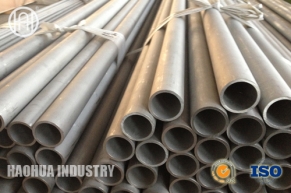


ASTM A213 TP904L Heat Resistant Stainless Steel Seamless Tube
| 904L is a non-stabilised low carbon high alloy austenitic stainless steel. The addition of copper to this grade gives it greatly improved resistance to strong reducing acids, particularly sulphuric acid. It is also highly resistant to chloride attack - both pitting / crevice corrosion and stress corrosion cracking. This grade is non-magnetic in all conditions and has excellent weldability and formability. The austenitic structure also gives this grade excellent toughness, even down to cryogenic temperatures. 904L does have very substantial contents of the high cost ingredients nickel and molybdenum. Many of the applications in which this grade has previously performed well can now be fulfilled at lower cost by duplex stainless steel 2205 (S31803 or S32205), so it is used less commonly than in the past. |
904L Stainless Steel Pipes and Tubes Product Range
904L Stainless Steel Pipes and Tubes Specifications: ASTM A/ASME SA 269/677 904L Stainless Steel Pipes and Tubes Sizes (Seamless): 1/2" NB - 8" NB
904L Stainless Steel Pipes and Tubes Sizes (ERW): 1/2" NB - 24" NB
904L Stainless Steel Pipes and Tubes Sizes (EFW): 6" NB - 100" NB
904L Stainless Steel Pipes and Tubes Wall Thickness available:
Schedule 5S - Schedule XXS (heavier on request)
904L Stainless Steel Pipes and Tubes Other Materials Testing:
NACE MR0175, H2 SERVICE, OXYGEN SERVICE, CRYO SERVICE, etc.
904L Stainless Steel Pipes and Tubes Dimensions:
All Pipes is manufactured and inspected/tested to the relevant standards including ASTM, ASME and API etc.
Key Properties
These properties are specified for flat rolled product (plate, sheet and coil) in ASTM B625. Similar but not necessarily identical properties are specified for other products such as pipe, tube and bar in their respective specifications.
Composition
Table 1. Composition ranges for 904L grade of stainless steels.
Grade |
C |
Mn |
Si |
P |
S |
Cr |
Mo |
Ni |
Cu |
|
|
904L |
min. |
- |
- |
- |
- |
- |
19.0 |
4.0 |
23.0 |
1.0 |
Mechanical Properties
Table 2. Mechanical properties of 904L grade stainless steels.
Grade |
Tensile Strength (MPa) min |
Yield Strength 0.2% Proof (MPa) min |
Elongation (% in 50mm) min |
Hardness |
|
|
Rockwell B (HR B) |
Brinell (HB) |
||||
|
904L |
490 |
220 |
35 |
70-90 typical |
- |
|
Rockwell Hardness value range is typical only; other values are specified limits. |
|||||
Physical Properties
Table 3. Typical physical properties for 904L grade stainless steels.
Grade |
Density |
Elastic Modulus |
Mean Co-eff of Thermal Expansion (m/m/C) |
Thermal Conductivity |
Specific Heat 0-100C |
Elec Resistivity |
|||
|
0-100C |
0-315C |
0-538C |
At 20C |
At 500C |
|||||
|
904L |
8000 |
200 |
15 |
- |
- |
13 |
- |
500 |
850 |
Grade Specification Comparison
Table 4. Grade specifications for 904L grade stainless steels.
Grade |
UNS No |
Old British |
Euronorm |
Swedish SS |
Japanese JIS |
||
|
BS |
En |
No |
Name |
||||
|
904L |
N08904 |
904S13 |
- |
1.4539 |
X1NiCrMoCuN25-20-5 |
2562 |
- |
|
These comparisons are approximate only. The list is intended as a comparison of functionally similar materials not as a schedule of contractual equivalents. If exact equivalents are needed original specifications must be consulted. |
|||||||
Possible Alternative Grades
Table 5. Possible alternative grades to 904L stainless steel.
Grade |
Why it might be chosen instead of 904L |
|
316L |
A lower cost alternative, but with much lower corrosion resistance. |
|
6Mo |
A higher resistance to pitting and crevice corrosion resistance is needed. |
|
2205 |
A very similar corrosion resistance, with the 2205 having higher mechanical strength, and at a lower cost to 904L. (2205 not suitable for temperatures above 300C.) |
|
Super duplex |
Higher corrosion resistance is needed, together with a higher strength than 904L. |
Corrosion Resistance
Although originally developed for its resistance to sulphuric acid it also has a very high resistance to a wide range of environments. A PRE of 35 indicates that the material has good resistance to warm sea water and other high chloride environments. High nickel content results in a much better resistance to stress corrosion cracking than the standard austenitic grades. Copper adds resistance to sulphuric and other reducing acids, particularly in the very aggressive "mid concentration" range.
In most environments 904L has a corrosion performance intermediate between the standard austenitic grade 316L and the very highly alloyed 6% molybdenum and similar "super austenitic" grades.
In aggressive nitric acid 904L has less resistance than molybdenum-free grades such as 904LL and 310L.
For maximum stress corrosion cracking resistance in critical environments the steel should be solution treated after cold work.
Heat Resistance
Good resistance to oxidation, but like other highly alloyed grades suffers from structural instability (precipitation of brittle phases such as sigma) at elevated temperatures. 904L should not be used above about 400C.
Heat Treatment
Solution Treatment (Annealing) - heat to 1090-1175C and cool rapidly. This grade cannot be hardened by thermal treatment.
Welding
904L can be successfully welded by all standard methods. Care needs to be taken as this grade solidifies fully austenitic, so is susceptible to hot cracking, particularly in constrained weldments. No pre-heat should be used and in most cases post weld heat treatment is also not required. AS 1554.6 pre-qualifies Grade 904L rods and electrodes for welding of 904L.
Fabrication
904L is a high purity, low sulphur grade, and as such will not machine well. Despite this the grade can be machined using standard techniques.
Bending to a small radius is readily carried out. In most cases this is performed cold. Subsequent annealing is generally not required, although it should be considered if the fabrication is to be used in an environment where severe stress corrosion cracking conditions are anticipated.